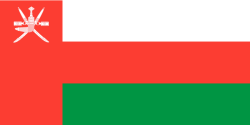Sultanate of Oman
Related Categories:
 Oman - Fotw
Oman - FotwThe flag carries the Sultanate's emblem of two crossed swords with a khanjar and belt superimposed.
www.fotw.us/flags/om.html Oman - wikipedia.org
The direct rule of the sultan gives Oman a largely stable economic and social system free of party politics. Sultan Qaboos, encourages market-orientated policies and private sector development as the mechanism for prosperity and growth.
en.wikipedia.org/
About 55% of the population lives in Muscat and the Batinah coastal plain northwest of the capital; about 215,000 live in the Dhofar (southern) region, and about 30,000 live in the remote Musandam Peninsula on the Strait of Hormuz. Some 660,000 expatriates live in Oman, most of whom are guest workers from South Asia, Egypt, Jordan, and the Philippines.
Since 1970, the government has given high priority to education to develop a domestic work force, which the government considers a vital factor in the country's economic and social progress. In 1986, Oman's first university, Sultan Qaboos University, opened. It has continued to expand, recently adding a law college, and remains the country’s only major public university. More than 300 full and partial scholarships are awarded each year for study abroad.
There are three private universities and twenty post-secondary education institutions in Oman, including a technical college, banking institute, teacher’s training college, and health sciences institute. A select few of these institutions offer four-year degrees, while the remainder provide two-year post-secondary diplomas. Since 1999, the government has embarked on reforms in higher education designed to meet the needs of a growing population. Approximately 40% of Omani high school graduates pursue some type of post-secondary education.
www.state.gov/r/
Introduction
About
Contact
Symbols in The News
Interpret this Symbol
AAC
African
AI
Alchemy
Alphabets
Ancient
Animal Symbolism
Architecture
Art
Articles
Astrology
Baha'i
Blissymbolics
Blueprint Symbols
Buddhist
Celtic Symbols
Cemetery
Chinese Symbols
Christian
Circle
City
Codes
Color
Conlangs
Crop Circles
Danger
Da Vinci Code
Designing Logos
Dictionaries
Dreams
Education
Egyptian Symbols
Electrical
Emoticons
Find Images
Fonts
Food
Fraternity
Hamsa
Healing
Heraldry
Hermetic
Highway Signs
Hindu
History
Hobo
Holiday
Icons
iConji
Islamic
Jain Symbols
Japanese, Kanji
Jewish
Justice
Law
Literary Symbolism
Mandalas
Map
Masonic
Math, Number
Meaning of Names
Medical
Middle East
Military
Miscellaneous
Money
Music
Mythology
Native American
Playing Cards
Power
Psychology
QiQiiKhu
Reiki
Religious
Runes, Norse
Sacred Geometry
Scientific
Science Fiction
Sorority
Sports
Symbols in the News
Tattoos
ThirteenSymbols
Tree of Life
Ursprache
Videos
Visual Languages
Weather
Web Codes
Wicca
Words
Writing Systems
Braille
Coinherence
Coptic
Cuneiform
Easter Island
Etruscan
Happy Human
Hebrew
Kokopelli
Linear B
Lotus
Love Symbols
Mandorla
Moon Alphabet
Nine Pointed Star
Om
Oz
Phonetic
Scarab Beetle
Silent
Theosophy
Unifon
About
Contact
Symbols in The News
Interpret this Symbol
AAC
African
AI
Alchemy
Alphabets
Ancient
Animal Symbolism
Architecture
Art
Articles
Astrology
Baha'i
Blissymbolics
Blueprint Symbols
Buddhist
Celtic Symbols
Cemetery
Chinese Symbols
Christian
Circle
City
Codes
Color
Conlangs
Crop Circles
Danger
Da Vinci Code
Designing Logos
Dictionaries
Dreams
Education
Egyptian Symbols
Electrical
Emoticons
Find Images
Fonts
Food
Fraternity
Hamsa
Healing
Heraldry
Hermetic
Highway Signs
Hindu
History
Hobo
Holiday
Icons
iConji
Islamic
Jain Symbols
Japanese, Kanji
Jewish
Justice
Law
Literary Symbolism
Mandalas
Map
Masonic
Math, Number
Meaning of Names
Medical
Middle East
Military
Miscellaneous
Money
Music
Mythology
Native American
Playing Cards
Power
Psychology
QiQiiKhu
Reiki
Religious
Runes, Norse
Sacred Geometry
Scientific
Science Fiction
Sorority
Sports
Symbols in the News
Tattoos
ThirteenSymbols
Tree of Life
Ursprache
Videos
Visual Languages
Weather
Web Codes
Wicca
Words
Writing Systems
Braille
Coinherence
Coptic
Cuneiform
Easter Island
Etruscan
Happy Human
Hebrew
Kokopelli
Linear B
Lotus
Love Symbols
Mandorla
Moon Alphabet
Nine Pointed Star
Om
Oz
Phonetic
Scarab Beetle
Silent
Theosophy
Unifon

